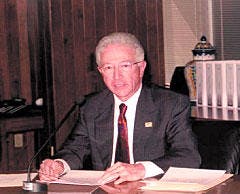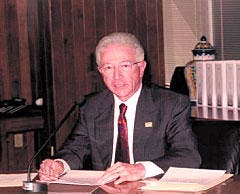In Mexico, we are living in times of change, with new demands being voiced by society. At all levels of government in Mexico programs are being developed to respond to this demand.
The office of the president of Mexico is insisting that federal offices and agencies work on the basis of a new planning horizon of 25 years. A quarter-century vision is in sharp contrast to a tradition in the energy sector of planning for the 6-year presidential period. It must be admitted that, in practice, actual planning was the stepchild of budgetary and fiscal decisions taken outside of the state-owned energy companies.
The spirit or philosophy of planning in the administration of President Vicente Fox is one that asks a new question; it is not the old question, How can the government pay for all public services and infrastructure requirements? The new question is: How can the government design public policy and programs that attract the energy, creativity, and commitment of investors from private industry in ways that complement the efforts of the public sector?
In a recently published 150-page working paper, "Program of the Energy Sector, 2001-2006," of the Mexican Government, there is an analysis of the challenges, bottlenecks, and outlook of both the oil and power sectors.
We feel the wind behind our back that comes from President Fox that is pushing us to work faster and more ambitiously in devising ways to strengthen the oil sector in this administration and in those to follow.
We also feel, as Mexicans and as oil industry professionals, the dramatic change of circumstances and concerns that have appeared in the wake of the terrorist attacks of Sept. 11, 2001. Our government has supported the efforts of the international community to eliminate the curse of terrorism in today's world. For our part, we in Pemex intend to strengthen our ability to meet our national energy needs, and, within our capabilities, those of our region. We also intend to strengthen our own industrial security measures, for our own sake as well as for the sake of those countries that depend on us for petroleum supplies.
There are three basic challenges that we in Pemex face today. One is to define new roles for private industry in the expansion of the petroleum sector in Mexico.
A second challenge lies in modernizing our own corporate culture and philosophy of corporate governance.
Finally, there is the challenge of restructuring Pemex's fiscal and administrative relationships with the federal government.
Expanding capacity
Everyone realizes that, once the current downturn in the national and world economy comes to an end, Mexico will face sharp capacity constraints in both the oil and power sectors.
Mexico will face not only constraints of capacity but also of commercial balance. By some estimates, Mexico by 2006 will end up importing a fifth or more of its supplies of natural gas. The same outlook applies to refined petroleum products and petrochemicals.
The logical extreme of these trends is that Mexico could become a net importer in the foreseeable future of not only natural gas but of refined petroleum products and crude oil as well. The effect of such a situation on public finances is not one that will bring smiles to anyone in the federal government.
Pemex proposal
The simple idea is that Pemex is looking for new ways within the existing legal and regulatory framework to strengthen the weight and efficiency of private industry in the petroleum industry.
Implementing this idea will take distinct forms in each of the industrial areas in which we have operations.
Take, for example, the area of dry gas production. Here, our new idea is to devise a concept that we have called "Multiple Service Contract." We are in the process of polishing the details.
In saying "details," I do not mean final details, as these will emerge only after collaborative consultations with prospective contractors.
The idea is to launch a pilot project in the northern Burgos basin. Qualified companies will be invited to bid on fairly large blocks with the commitment to increase dry gas production under the terms of a long-term contract. Tenders will be for blocks in which there exist internationally certified, proved reserves of natural gas. The award will be made in a given case to the company that offers the best program for the development and expansion of the tendered block. Our approach to compensation is to conceive of incentives in terms of cost management.
The same general logic will apply to efforts in other areas such as petrochemicals and refining-the goal will be to find innovative ways to attract investors within the existing legal framework.
Modernizing Pemex
In the spirit of contemporary corporate strategy, we are reengineering the future: We start from a point in the future where we want to be, then work backwards to the present.
The future for Pemex as a whole is too broad a topic to capture in a few words. We may consider one example of how we plan to manage the future. Consider the area of strategic planning. Whereas in 1992 Pemex was divided into four operating business units, the function of planning was delegated downward to the people in the field.
This strategy had mixed results. Consciously or not, our business units planned for themselves, without necessarily taking into account sufficiently the needs of the sister organizations. So what have we done to address this awkward situation in our corporate culture and model of governance?
We have created four new executive positions at the level of senior vice-president: three of these deal with the future, and one with the present. The future-oriented corporate jobs are director of strategic planning, director of modernization and innovation, and director of engineering and projects. The responsibility for the orchestration and monitoring of our ongoing business operations corresponds to the corporate director of operations.
The experienced managers that have been appointed to these positions are taking up the reins of corporate planning, modernization project, management, and execution.
Steps such as these are being taken throughout Pemex at different levels. We are looking for better leadership, and, with it, better accountability of performance. The marching orders that I have given in Pemex are three words: "Be more ambitious."
Pemex's compact with government
Regarding the need to restructure Pemex's fiscal and administrative compact with the federal government, let me illustrate the point by saying that, in 2000, Pemex had 274 billion pesos of taxable income-but paid 294 billion pesos in federal taxes.
It isn't necessary to know the exchange rate of the Mexican peso in that year to see that we lost money owing to an excessive fiscal system. It will also be obvious that Pemex does not operate under an accounting system in which the concept of retained earnings carries much weight.
A point of history should be kept in mind to understand our present situation. The collapse of the great oil boom of 1977-81 catapulted not only Mexico but the rest of Latin America as well into what is ruefully called here "the Lost Decade of the '80s."
In 1981, the oil market began to turn south, which, in conjunction with other factors, provoked a debt crisis for the Mexican government.
In 1986, crude oil prices fell abruptly, and at least one cargo of Mexican crude was sold at under $5/bbl. In Mexico, this loss of innocence in the world oil market gradually provoked a loss of trust in Pemex. Since then, Pemex has lived in a world of external controls, "padlocks," permit requirements, and audits.
Mexican society and the federal government acted in this way partly from the perception that we ourselves had not implemented our own internal controls to monitor industrial and commercial operations.
Still, at present, we are swimming in paperwork requirements, financial disincentives, and lack of management authority, which together suggest an image of corporate inefficiency. Most of these padlocks, as we have called them, were put in place in another era. One important padlock is on our upside earnings potential. Where the observed international price of crude oil is higher than the value given in the federal budget, the government keeps all of the incremental difference.
Today, we are in the process of installing the management machinery necessary to monitor, control, and take responsibility for our actions. Our internal estimate is that there is a cool $1 billion to be saved annually by modernizing Pemex's administrative interface with the federal government and the Congress. As a result of all of these efforts in the areas of savings, improved efficiency, and new relationships, Pemex intends to grow.
Conclusions
In all that we propose for Pemex, we want better transparency so that our government, our Congress, and the Mexican people regain a trust in our ability to achieve new levels of production, reserves, and sustainable development in Mexico's petroleum industry.
We do not expect to do this alone. We look forward to new relationships, be they of the character of strategic alliances or new contractor-customer formulas.
In all of these new relationships, we want to harness the technology, capital, and drive of private industry to our own goals of expanded capacity, better profits, sustainable development, and enhanced management accountability.



